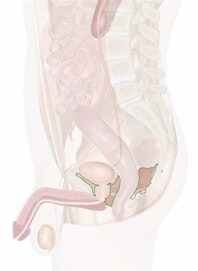The Urogenital Diaphragm
Explore the anatomy and vital role of the urogenital diaphragm with Innerbody's interactive 3D model.

The urogenital diaphragm is a muscular sheet found in the pelvic cavity. It plays a vital role in the urinary and reproductive systems by supporting the urinary bladder, urethra, penis, vagina, and clitoris. The urogenital diaphragm also forms part of the body wall that separates delicate internal organs from the body’s exterior.
Anatomy
The urogenital diaphragm is a membrane-covered wall of skeletal muscle tissue found in the pelvic region and forms the anterior portion of the pelvic diaphragm. It is a triangular sheet extending from the pubic symphysis on its anterior corner, running along the medial border of the hip bones and reaching its posterior end at the superficial transverse perineal muscle. Both the urinary and genital orifices pierce through the urogenital diaphragm along the body’s midline. Also on the midline is the perineal body, a strong tendon that supports the surrounding muscles and connects the anus to the vaginal orifice in females or to the penis in males.
Several skeletal muscles make up the bulk of the urogenital diaphragm. The deep transverse perineal muscle is a broad, triangular muscle that arises from the ischium, covers the space around the urogenital orifices, and inserts on the perineal body. Surrounding the urethra is the external urethral sphincter, which arises from the pubis and ischium and inserts on the penis in males and the vagina in females. The bulbospongiosus muscle fills the medial space, arising from the perineal body and wrapping around the penis in males or around the vagina in females before inserting on the penis or clitoris. On the lateral edges of the urogenital diaphragm are the ischiocavernosus muscles, which arise from the ischium and pubis and extend anteriorly and medially to the penis in males or the clitoris in females. Finally, the superficial transverse perineal muscle is a narrow band of muscle that arises from the ischial tuberosity and inserts on the perineal body, forming the base of the urogenital triangle.
Covering the muscles of the urogenital diaphragm are a pair of thin, fibrous membranes: the superior and inferior fascia. The superior fascia of the urogenital diaphragm is the deepest layer of the diaphragm, located between the bladder in females or the prostate in males and the diaphragm muscles. On the superficial end of the diaphragm is the inferior urogenital diaphragm, which borders the subcutaneous tissues of the pelvis. Both membranes are made of dense irregular connective tissue and help to give strength to the structure of the urogenital diaphragm.
Physiology
The urogenital diaphragm plays several important roles in the urinary and reproductive systems. Contraction of the bulbospongiosus, deep transverse perineal, and external urethral sphincter muscles help to propel urine out of the urethra at the end of urination and, in males, propels semen during ejaculation. Relaxation of the external urethral sphincter opens the urethra and allows urine to flow out of the urinary bladder. The bulbospongiosus and ischiocavernosus muscles work together to produce erection of the penis in males or the clitoris in females. All of the muscles and membranes of the urogenital diaphragm also act as part of the body wall to support and protect the surrounding organs and hold the genitals and urinary organs in their correct positions.


